
An octopus is a soft-bodied, eight-limbed mollusc of the order Octopoda. The order consists of some 300 species and is grouped within the class Cephalopoda with squids, cuttlefish, and nautiloids. Like other cephalopods, an octopus is bilaterally symmetric with two eyes and a beaked mouth at the center point of the eight limbs. The soft body can radically alter its shape, enabling octopuses to squeeze through small gaps. They trail their eight appendages behind them as they swim. The siphon is used both for respiration and for locomotion, by expelling a jet of water. Octopuses have a complex nervous system and excellent sight, and are among the most intelligent and behaviourally diverse of all invertebrates.

A cephalopod is any member of the molluscan class Cephalopoda such as a squid, octopus, cuttlefish, or nautilus. These exclusively marine animals are characterized by bilateral body symmetry, a prominent head, and a set of arms or tentacles modified from the primitive molluscan foot. Fishers sometimes call cephalopods "inkfish", referring to their common ability to squirt ink. The study of cephalopods is a branch of malacology known as teuthology.
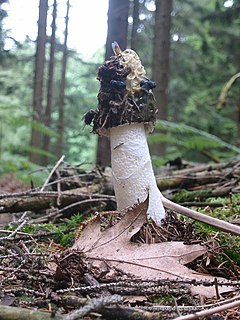
Phallaceae is a family of fungi, commonly known as stinkhorns, within the order Phallales. Stinkhorns have a worldwide distribution, but are especially prevalent in tropical regions. They are known for their foul-smelling, sticky spore masses, or gleba, borne on the end of a stalk called the receptaculum. The characteristic fruiting-body structure, a single, unbranched receptaculum with an externally attached gleba on the upper part, distinguishes the Phallaceae from other families in the Phallales. The spore mass typically smells of carrion or dung, and attracts flies, beetles and other insects to help disperse the spores. Although there is great diversity in body structure shape among the various genera, all species in the Phallaceae begin their development as oval or round structures known as "eggs". According to a 2008 estimate, the family contains 21 genera and 77 species.
A gelatinous cube is a fictional monster from the Dungeons & Dragons fantasy role-playing game. It is described as a ten-foot cube of transparent gelatinous ooze, which is able to absorb and digest organic matter.

The vampire squid is a small cephalopod found throughout temperate and tropical oceans in extreme deep sea conditions. The vampire squid uses its bioluminescent organs and its unique oxygen metabolism to thrive in the parts of the ocean with the lowest concentrations of oxygen. It has two long retractile filaments, located between the first two pairs of arms on its dorsal side, which distinguish it from both octopuses and squids, and places it in its own order, Vampyromorphida, although its closest relatives are octopods. As a phylogenetic relict, it is the only known surviving member of its order.
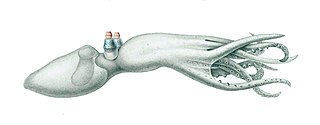
Amphitretus is a genus of pelagic gelatinous octopuses. It is the sole genus of subfamily Amphitretinae, one of three subfamilies in the family Amphitretidae and consists of two species. Some authorities consider Amphitretus thielei as a subspecies of Amphitretus pelagicus, which would make the genus monotypic.

Ocythoe tuberculata, also known as the tuberculate pelagic octopus or football octopus, is a pelagic octopus. It is the only known species in the family Ocythoidae.

Opisthoteuthis californiana, also known as the flapjack octopus or adorabilis, is a species of umbrella octopus.

Tremoctopus is a genus of pelagic cephalopods, containing four species that occupy surface to mid-waters in subtropical and tropical oceans. They are commonly known as blanket octopuses, in reference to the long, transparent webs that connect the dorsal and dorsolateral arms of the adult females. The other arms are much shorter and lack webbing.

The giant Pacific octopus, also known as the North Pacific giant octopus, is a large marine cephalopod belonging to the genus Enteroctopus. Its spatial distribution includes the coastal North Pacific, along California, Oregon, Washington, British Columbia, Alaska, Russia, Japan, and Korean Peninsula. It can be found from the intertidal zone down to 2,000 m (6,600 ft), and is best adapted to cold, oxygen-rich water. It is the largest octopus species, based on a scientific record of a 71-kg (156-lb) individual weighed live.

Incirrata is a suborder of the order Octopoda. The suborder contains the classic "benthic octopuses," as well as many pelagic octopus families, including the paper nautiluses. The incirrate octopuses are distinguished from the cirrate octopuses by the absence in the former of the "cirri" filaments for which the cirrates are named, as well as by the lack of paired swimming fins on the head, and lack of a small internal shell.

Octopodiformes is a superorder of the subclass Coleoidea, comprising the octopuses and the vampire squid. All living members of Octopodiformes have eight arms, either lacking the two tentacles of squid or modifying the tentacles into thin filaments. Octopodiformes is often considered the crown group of octopuses and vampire squids, including all descendants of their common ancestor. Some authors use the term Vampyropoda for the same general category, though others use "Vampyropoda" to refer to the total group. Another term is Octobranchia, referring to cephalopods without prominent tentacles.
A blanket is a large, usually rectangular piece of thick bedding material.
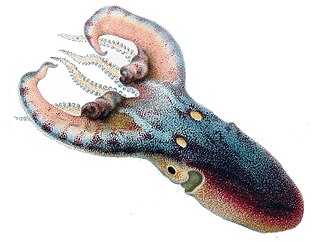
The common blanket octopus or violet blanket octopus is a large octopus of the family Tremoctopodidae found worldwide in the epipelagic zone of warm seas. The degree of sexual dimorphism in this species is very high, with females growing up to two meters in length, whereas males grow to about 2.4 cm. The first live specimen of a male was not seen until 2002 off the Great Barrier Reef. Individual weights of males and females differ by a factor of about 10,000 and potentially more.
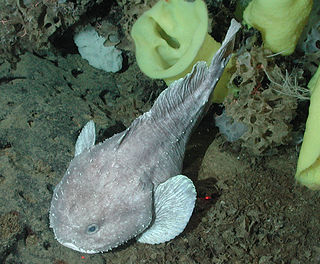
The blob sculpin is a species of deep-sea fish of the family Psychrolutidae. It feeds mainly on crustaceans, molluscs, and sea pens.

The seven-arm octopus is one of the two largest known species of octopus; based on scientific records, it has a maximum estimated total length of 3.5 m (11 ft) and mass of 75 kg (165 lb). The only other similarly large extant species is the giant Pacific octopus, Enteroctopus dofleini.
Eledone palari, the spongetip octopus, is a species of benthic octopus from the coastal waters of the eastern Indian Ocean and the south-western Pacific. The species was formally described in 1992 and is the first species of the genus Eledone to be discovered which is not distributed in the Atlantic Ocean.
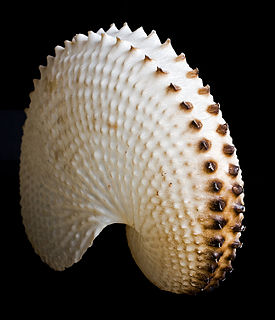
Argonautoidea is a superfamily of the suborder Incirrata containing all known argonautoids.

Cirrothauma is a genus of deep water octopuses from the cirrate family Cirroteuthidae. The species Cirrothauma are fragile, gelatinous deep-sea octopods with a shell, a moderate saddle, and triangular wings. Their eyes either have lenses, as seen in the species Cirrothauma murrayi or they have reduced eyes without lenses, shown in the other extant species Cirrothauma magna. Both species were placed in Cirrothauma due to the fact that they possess similar shells. These octopuses have been reported to live in all the world's oceans, except for the Southern Ocean.
Luteuthis shuishi is a species of octopus that lives in the South China Sea, which is known only from one female specimen collected at a depth of 767 meters. It has short arms and is quite gelatinous. The octopus's total length is about 300 millimeters.















